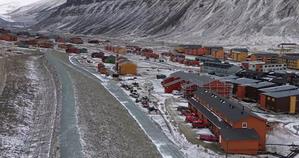
Norway Tightens Eco-Protection In Svalbard To Safeguard Arctic Ecosystem
Svalbard, a remote Arctic archipelago situated between mainland Norway and the North Pole, is known for its dramatic glaciers, polar bears, and seabird colonies. Its pristine wilderness attracts adventurers and researchers alike, but the region's delicate environment faces mounting pressures from rising temperatures and increased human activity, Xinhua news agency reported.
"We have seen growing pressure from tourism that impacts nature, cultural heritage, and wildlife. At the same time, climate change is unfolding here and now," said acting Minister of Climate and Environment Tore Sandvik in a press release. "To preserve Svalbard's wilderness, we are updating the regulatory framework to address these challenges," he added.
Among the key measures is a mandate to maintain stricter distances from polar bears, ensuring minimal disturbance to the vulnerable species.
Visitors must now stay 300 metres away from polar bears year-round, with the distance increasing to 500 metres from March to June during the animals' most sensitive period.
Drones use near bird cliffs is banned during breeding seasons from April to August to reduce noise and disturbance. Additionally, landing in protected areas will now be tightly regulated, with exceptions for only 43 mapped areas or snow-covered grounds in specific zones.
Passenger ships will face new restrictions, allowing no more than 200 passengers in protected areas at a time.
The use of drones and underwater vehicles are also banned in protected areas to mitigate environmental disruption.
Motorised traffic will see tighter controls, including a permanent ban on driving over sea ice in certain fjords after March 1. However, electric bicycles and pedal bicycles are now permitted on snow and ice in select national parks, promoting eco-friendly exploration.
New rules also aim to protect walruses and birds by enforcing speed limits and distance requirements near their habitats. Fast ice-breaking activities are largely prohibited, except for maintaining vital port access and Coast Guard operations.
The changes come as Svalbard is warming up five to seven times faster than the global average, with the expansion of tourism into previously untouched and sensitive areas.

Legal Disclaimer:
MENAFN provides the information “as is” without warranty of any kind. We do not accept any responsibility or liability for the accuracy, content, images, videos, licenses, completeness, legality, or reliability of the information contained in this article. If you have any complaints or copyright issues related to this article, kindly contact the provider above.
Most popular stories
Market Research

- Manuka Honey Market Report 2024, Industry Growth, Size, Share, Top Compan...
- Modular Kitchen Market 2024, Industry Growth, Share, Size, Key Players An...
- Acrylamide Production Cost Analysis Report: A Comprehensive Assessment Of...
- Fish Sauce Market 2024, Industry Trends, Growth, Demand And Analysis Repo...
- Australia Foreign Exchange Market Size, Growth, Industry Demand And Forec...
- Cold Pressed Oil Market Trends 2024, Leading Companies Share, Size And Fo...
- Pasta Sauce Market 2024, Industry Growth, Share, Size, Key Players Analys...






















Comments
No comment